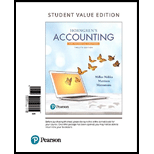
Making product mix decisions
Learning Objective 3
2. CM per MHr, Regular $441
Tread Light produces two types of exercise treadmills: regular and deluxe. The exercise craze is such that Tread Light could use all its available machine hours to produce either model. The two models are processed through the same production departments. Data for both models are as follows:
| Per Unit | ||
| Deluxe | Regular | |
| Sales price | $1,030 | $610 |
| Costs: | ||
| Direct materials | 320 | 130 |
| Direct labor | 88 | 180 |
| Variable manufacturing overhead | 270 | 90 |
| Fixed manufacturing overhead* | 102 | 34 |
| Variable operating expenses | 121 | 63 |
| Total costs | 901 | 497 |
| Operating income | $ 129 | $ 113 |
Requirements
1. What is the constraint?
2 Which model should Tread Light produce? (Hint: Use the allocation of fixed manufacturing overhead to determine the proportion of machine hours used by each product.)
3. If Tread Light should produce both models, compute the mix that will maximize operating income.
Want to see the full answer?
Check out a sample textbook solution
Chapter 25 Solutions
Horngren's Accounting, The Financial Chapters, Student Value Edition Plus MyLab Accounting with Pearson eText - Access Card Package (12th Edition)
- Please give me true answer this financial accounting questionarrow_forwardUsing the graph below as a reference, explain why an initial investment of $50,000 leads to a larger future value than investing $1,000 each year for the next 50 years. Also consider when a larger initial investment may not be a viable option, what alternatives are there to grow the value of your investment.arrow_forwardAnswer? ? Financial accounting questionarrow_forward
- Sandy Inc. estimates that its employees will utilize 176,000 machine hours during the coming year. Total overhead costs are estimated to be $7,300,000 and direct labor hours are estimated to be 100,000. Actual machine hours are 120,000. Actual labor hours are 75,000. If Sandy Inc. allocates overhead based on machine hours, what is the predetermined manufacturing overhead rate? I want Solutionarrow_forwardCan you provide answer this general accounting question?arrow_forward4 POINTSarrow_forward
- Tutor need your advicearrow_forwardDuring a period of time, Nova Systems Inc. reported that total liabilities decreased by $55,300 and stockholders' equity increased by $33,800. By what amount and direction must total assets change during that same period? a) $89,100 increase b) $21,500 decrease c) $89,100 decrease d) $21,500 increase accurate answerarrow_forward???!!!arrow_forward
- Principles of Accounting Volume 2AccountingISBN:9781947172609Author:OpenStaxPublisher:OpenStax College
 Essentials of Business Analytics (MindTap Course ...StatisticsISBN:9781305627734Author:Jeffrey D. Camm, James J. Cochran, Michael J. Fry, Jeffrey W. Ohlmann, David R. AndersonPublisher:Cengage Learning
Essentials of Business Analytics (MindTap Course ...StatisticsISBN:9781305627734Author:Jeffrey D. Camm, James J. Cochran, Michael J. Fry, Jeffrey W. Ohlmann, David R. AndersonPublisher:Cengage Learning Cornerstones of Cost Management (Cornerstones Ser...AccountingISBN:9781305970663Author:Don R. Hansen, Maryanne M. MowenPublisher:Cengage Learning
Cornerstones of Cost Management (Cornerstones Ser...AccountingISBN:9781305970663Author:Don R. Hansen, Maryanne M. MowenPublisher:Cengage Learning  Managerial AccountingAccountingISBN:9781337912020Author:Carl Warren, Ph.d. Cma William B. TaylerPublisher:South-Western College Pub
Managerial AccountingAccountingISBN:9781337912020Author:Carl Warren, Ph.d. Cma William B. TaylerPublisher:South-Western College Pub



